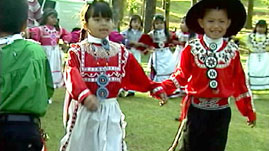Teachers' Domain - Digital Media for the Classroom and Professional Development
User: Preview

Source: The Mississippi Band of Choctaw Indians
This video, adapted from material provided by the ECHO partners, illustrates some of the traditional activities that connect the Mississippi Band of Choctaw Indians to their past. Activities include traditional dances, the use of traditional instruments such as the Choctaw drum and dance sticks, and participation in games like stickball.
People from all cultures and places have used storytelling to pass on traditions, values, and beliefs that communicate information about history, nature, and more. These stories are shared in a variety of ways, including oral retellings, written text, art, and music. The Mississippi Band of Choctaw Indians assemble for dances and songs with pride to pass on traditions and values from one generation to the next.
The Choctaw trace their origins to the Nanih Waiya mound (Sloping Hill)—located in Winston County, Mississippi. In the early 1800s, a series of treaties gradually robbed the Choctaw people of their rich agricultural land, which became the property of the United States government. The last of these treaties, the Treaty of Dancing Rabbit Creek in 1830, stripped the Choctaw of their remaining lands and forcibly removed them to Indian territories in Oklahoma (Choctaw for "Red Land"). Thousands of Choctaw people died on this long journey, which came to be known as the "Trail of Tears." A small remnant refused to leave, and eventually became the Mississippi Band of Choctaw Indians.
The dances of the Mississippi Choctaw reflect aspects of Choctaw life. Dancers typically follow the rise and fall of a chanter's voice and the rhythm set by striking together Choctaw dance sticks. The dances, which are intended for participation, not simply viewing, express the spirit of cooperation that is valued by the Choctaw people. This can be seen in the way everyone comes together during a dance. Although dance steps and chants may vary slightly among Choctaw communities, all dances fall into one of three categories: social dances, animal dances, and war dances.
Social dances reflect the ties that weave Choctaw communities together. For example, the "Wedding Dance" celebrates marriages, and the "Friendship Dance" recognizes the close bonds within the Tribe. The Choctaw people have adapted elements of other cultures—such as European-style clothing—and this tradition of adaptation appears in the "House Dance." This dance integrates elements from various sources, including Anglo-American square dance, fiddle tunes, and dance steps from the French "quadrille," another type of square dance.
Animal dances honor the creatures that the Choctaw respect for what they teach about survival, and for the resources they provide for the Tribe's daily existence. For example, the "Quail Dance" honors that bird's ability to blend into the surrounding landscape, a skill that Choctaw hunters and warriors learned to emulate.
Finally, early Choctaw people used war dances to prepare for battle. Choctaw War Dances are unusual because they are one of the few tribal war dances in which women dance along with men.
Dances are one of the many ways that Choctaw people are able to pass on their centuries-old traditions to each new generation. The Choctaw drum, their oldest traditional instrument, is still used today at stickball games and as a signal call to dance. Traditional dress, crafts, and sports—in addition to oral and written storytelling—are some of the other ways that the Choctaw people, and people from cultures around the world, carry on their traditions, values, and beliefs.
 Loading Standards
Loading Standards Education through Cultural and Historical Organizations (ECHO) offers you resources on Teachers' Domain that strengthen knowledge of local culture and identity.
Education through Cultural and Historical Organizations (ECHO) offers you resources on Teachers' Domain that strengthen knowledge of local culture and identity.
